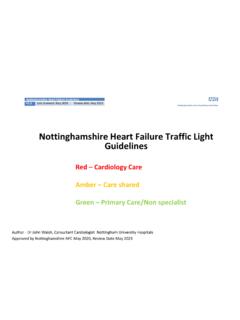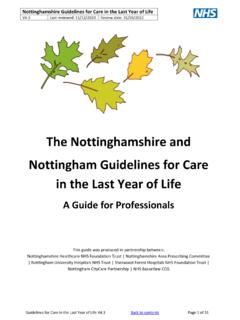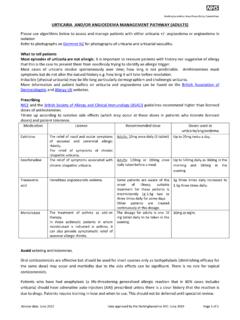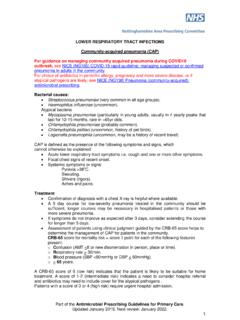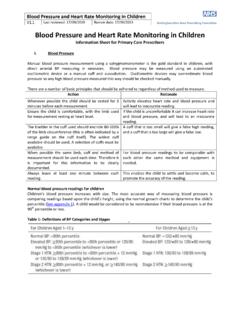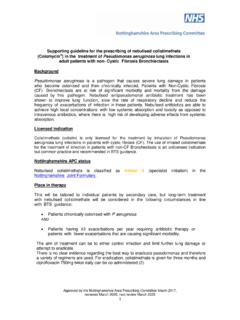Transcription of Nottinghamshire COPD Guidelines - NottsAPC
1 Nottinghamshire copd Guidelines Get the diagnosis right: clinical history and quality-assured diagnostic spirometry copd diagnosis: Age > 35yrs and usually current smoker or ex-smoker with 1 or more symptoms: Exertional breathlessness, Chronic cough or wheeze, Regular sputum production History of chest infections Confirm diagnosis with spirometry FEV1 < 80% predicted (although occasionally >80%) and post bronchodilator FEV1/FVC ratio < 70% and symptoms typical of copd Measure BMI Do CXR/FBC, ECG to assess for co-morbidities. Consider co-morbidities eg CVD/Mental health problems and optimise treatment Observe for red flag symptoms such as haemoptysis Exclude markers of asthma: Variable chest tightness; wheeze; cough and breathlessness Night-time waking Significant diurnal variation of symptoms and peak expiratory flow Symptoms related to work Normalisation of spirometry after inhaled 2-agonist or a course of inhaled/oral corti-costeroids) Ensure highest value interventions are offered to all patients and revisit at every review Stop smoking: only clinically effective intervention to slow disease progression.
2 All patients should be provided with a brief intervention, advised to quit and sign posted to stop smoking services Refer for pulmonary rehabilitation - if copd with MRC dyspnoea score 3-5, OR if functionally limited regardless of their MRC score. Consider re-referral if frequent exacerbations or more than a year since last course Give vaccinations - influenza annually / pneumococcal PPV23 (one off) as per 'Green Book' Optimise treatment for comorbidities and co-develop a self management plan in collaboration with the patient and their family members or carers as appropriate Consider medication: Drug treatment should be guided by breathlessness and exercise limitation, exacerbation frequency, symptoms, disability and physiological complications that the patient experiences.
3 At different times in the natural history of their disease different features may predominate and their management should change to reflect this. Agree with patient that new treatment is done as a trial and stop if no benefit. Discuss risks and benefits of starting treatment ie risks of ICS Review Regularly: Stop new treatment if patient feels no improvement (symptomatic benefit is expected in 4 weeks, longer may be needed for reduction in exacerbations) For those patients with a self management plan consider exacerbation Emergency Supply Pack : 30mg prednisolone OD for 5 days &/or doxycycline or amoxicillin for 5 days. For further details, including 2nd line antibiotics, see guidance on 'Emergency Supply Packs' - note this may not be suitable for all patients Oxygen Saturations 92% on more than one occasion when stable on optimal medication or 6 weeks after exacerbation - refer to local oxygen assessment service Treatment Notes - Review all patients at least annually Check if treatment optimised at every opportunity.
4 Including review of inhaler technique and adherence before adding in therapy Caution: avoid inadvertent duplication when using combination products Oral corticosteroids (prednisolone) - Maintenance use of oral corticosteroid therapy in copd is not recommended and carries considerable risks ( osteoporosis, muscle wasting etc.). Do not start maintenance dose corticosteroids in primary care, refer for specialist review Consider osteoporosis prophylaxis for patients having 3 courses of steroid within 12 months and think bone health in all patients Macrolide antibiotics ( azithromycin). Initiated and guided by specialist respiratory physician only, aimed to reduce frequency of exacerbations.
5 Review for appropriateness if ongoing exacerbations . NB: ineffective if smoker. Be aware of risk of hearing loss, reversible if stopped early Ratified by Nottinghamshire APC: April 2021 ( updated Dec 21) Review Date: April 2024 All breathless patients Before a new prescrip-tion: Optimise current thera-py before adding in new treatment Check adherence with medicines (view issue history on GP system) Teach inhaler tech-nique before prescrib-ing and ask patients to demonstrate technique regularly Provide and update plan for responding to symptoms Use spacer to optimise inhaler technique if using MDI Check if the treatment is optimised by asking the patient: Has your treatment made a difference to you?
6 Is your breathing easier? Can you do things now that you could not do at all before? Can you do the same things as before but are you less breathless now? Has your sleep im-proved? Chronic Productive Cough If tenacious sputum consider (less evidence of benefit) trial of carbocisteine 750mg TDS for up to 4 weeks and stop if no improvement. If improvement in sputum pro-duction/reduction in viscosi-ty, reduce to 750mg BD. Con-sider titrating dose according to symptoms (not exceeding doses above). Role for long term use is not clear. Should not be used routinely to pre-vent exacerbations in pa-tients with stable copd . Con-sider physio referral for chest clearance techniques.
7 Exacerbations Symptoms (persistent >48 hours) of an exacerbation include: Change in sputum colour/increased quantity of spu-tum - start antibiotics Increased breathlessness - start oral steroids If not effective re-assess with FBC and sputum culture be-fore prescribing further anti-biotics. Consider a chest X-ray and re-confirm diagnosis. See copd self- management plan *Increased risk of side effects (including pneumonia) in patients taking ICS Use ICS with caution in any person with a history of chest X-ray confirmed pneumonia. Review patients who develop pneumonia whilst on ICS, consider on-going need, switching product or weaning/stopping (see p4) Offer - strong recommendation Consider - recommendation for which evidence of benefit is less certain This guidance on inhaled therapy is in line with NICE and may not be covered by licensed indications Inhaled therapy During COVID-19, DO NOT make changes to treatment in stable patients unless clinically indicated If patient limited by symptoms/has exacerbations and has asthmatic features/features suggesting steroid responsiveness.
8 - Previous secure diagnosis of asthma/atopy - Higher eosinophil count - Substantial variation in FEV1 over time ( 400ml) or substantial diurnal variation in PEFR ( 20%) Consider (less evidence of benefit) *ICS/LABA (inhaled corticosteroid/long-acting 2-agonist) combination inhaler If patient has day to day symptoms that adversely impact on quality of life or has 1 severe (requiring hospitalisation) or 2 moderate (requiring oral steroids/antibiotics) exacerbations within a year Offer *ICS/LABA/LAMA (ideally as a triple combination inhaler) Document in clinical records reason for continuing or stopping ICS treatment Offer Salbutamol (short-acting 2-agonist/SABA) or Ipratropium (short-acting muscarinic antagonist/SAMA) as required - SABA may continue at all stages, stop SAMA if LAMA started If patient limited by symptoms/has exacerbations and has no asthmatic features/features suggesting steroid responsiveness Offer LAMA/LABA (long-acting muscarinic antagonist/long-acting 2-agonist)
9 Combination inhaler Existing patients who are stable on LAMA or LABA alone can continue until appropriate to change If patient has day to day symptoms that adversely affect quality of life Consider (less evidence of benefit) 3 month trial of *ICS/LABA/LAMA (ideally as a triple combination inhaler) Review after 3 months and if no improvement, stop ICS and revert to LAMA/LABA. Document in clinical records reason for continuing or stop-ping ICS treatment If patient has 1 severe (requiring hospitalisation) or 2 moderate (requiring oral steroids/antibiotics) exacerba-tions within a year Consider (less evidence of benefit) *ICS/LABA/LAMA (ideally as a triple combination inhaler) Document in clinical records reason for continuing or stop-ping ICS treatment Consider referral if patient is still limited by breathlessness and/or having frequent exacerbations Inhaler device SABA or SAMA *LAMA prescribe by brand name LAMA/LABA prescribe by brand name ICS (moderate dose)
10 /LABA pre scribe by brand name Triple therapy ICS (moderate dose) /LABA/LAMA prescribe by brand name Slow and steady inhala on Metered Dose Inhal er (MDI) Salbutamol 100mcg 2 puffs prn ( ) or Salamol Easi breathe 100mcg 2 puffs prn ( ) or Ipratropium 20mcg 1 2 puffs PRN ( ) Bevespi Aerosphere (glycopyrronium/formoterol) TWO doses BD ( ) Fostair (beclometasone extrafine/ formoterol) 100/6mcg TWO puffs BD via spacer ( ) or Symbicort (budesonide/formoterol) 200 / 6mcg TWO puffs BD via spacer ( ) Trimbow (beclometasone extrafine/ formoterol/glycopyrronium) 87/5/9mcg TWO puffs BD via spacer ( ) Respimat so mist inhaler (SMI) Spiriva ( otropium) TWO puffs OD ( 23) ** Spiolto ( otropium/olodaterol) TWO puffs OD ( ) ** Dry Powder inhaler (DPI) quick and deep inhala on Easyhaler Salbutamol 100mcg 2 doses PRN ( ) Fobumix (budesonide/formoterol) 160 TWO doses BD or 320/9mcg ONE dose BD ( ) Turbohaler Terbutaline (Bricanyl ) 500mcg 1 dose PRN ( ) Symbicort (budesonide/formoterol) 200/6mcg TWO doses BD or 400/12mcg ONE dose BD ( 28) Genuair Eklira (aclidinium) 322mcg ONE dose BD ( ) Duaklir (aclidinium/formoterol) 340/12mcg ONE dose BD ( ) Ellipta Incruse (umeclidinium) 55mcg ONE dose OD ( ) Anoro (umeclidinium/vilanterol) 55/22mcg ONE dose OD ( )
